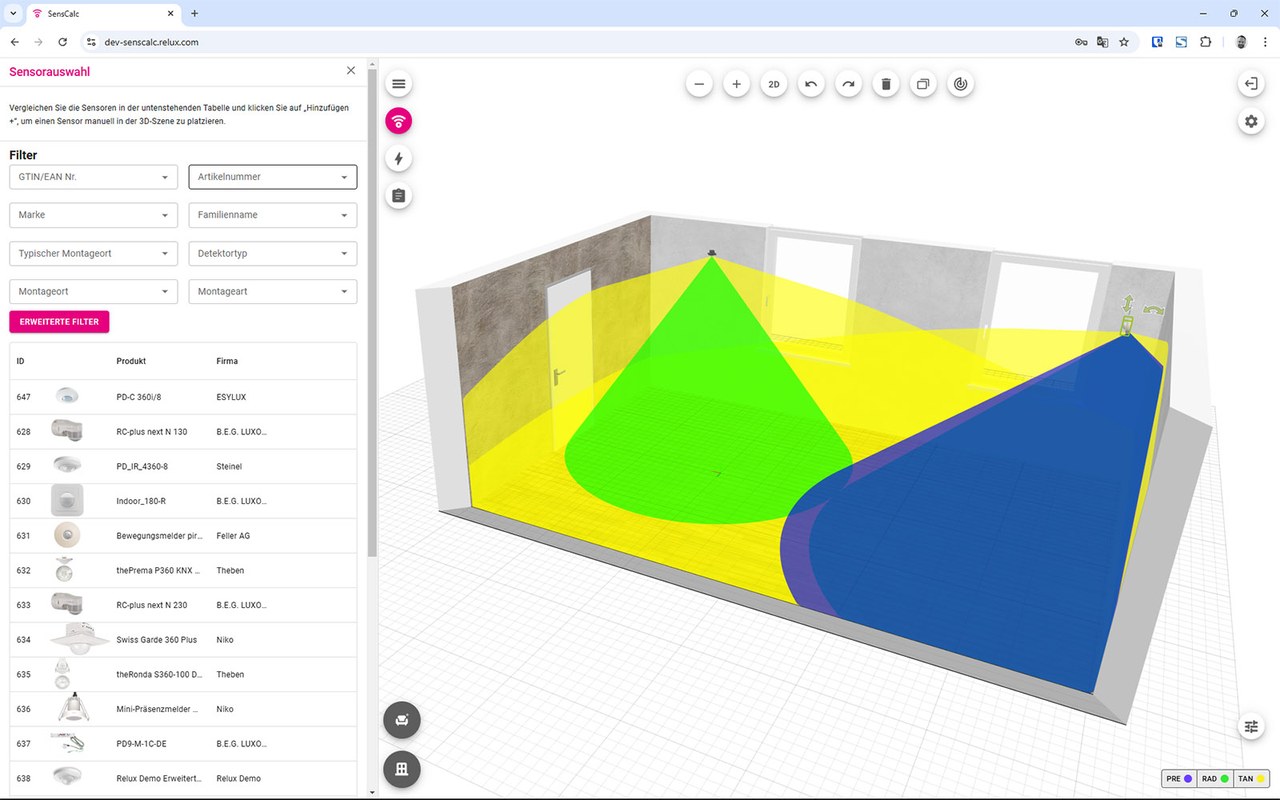New Unique Online Tool for Planning PIR Sensors with Energy and Amortisation Calculation
SensCalc is the free online planning tool for PIR sensors. The only online tool in the world. Calculate the energy efficiency and amortisation of your sensor installation with certified data in accordance with IEC 63180 and sensNORM 2022.
A RELUX planning tool developed in co-operation with Energie Schweiz, BFE, METAS, sensNORM and Schweizer Licht Gesellschaft SLG.
SensCalc provides electricians, planners and private individuals with a free online tool for planning PIR sensors. The platform enables energy and amortisation analyses directly on the website - innovative, practical and user-friendly.
Requirements for the planning of PIR sensors
Planning PIR sensors requires a large amount of data and calculations. In addition to the spatial conditions, such as room size and utilisation, parameters such as light intensity, sensor range and potential energy savings must also be taken into account. Planning errors can lead to inefficient systems that either do not provide the desired level of comfort or fail to achieve the desired energy savings.
Functionality and advantages
The online tool is accessible via the homepage www.senscalc.ch. After logging in (as a guest or with their own account), users can plan PIR sensors directly in the browser. The tool offers a wide range of functions:
1. Energy saving calculation:
SensCalc calculates the potential energy saving according to SIA 387/4 based on the parameters entered.
2. Amortisationanalysis:
The tool calculates the amortisation period of the planned installation and provides important economic key figures to help you make a decision.
3. Visualisation of sensor efficiency:
The tool displays the sensor coverage graphically, making the optimum placement visually visible.
4. User friendliness:
Thanks to the intuitive user interface, even complex projects are easy to carry out. The tool is suitable for both experienced professionals and beginners.
Relevance for the industry
The importance of PIR sensors in the context of energy efficiency should not be underestimated. According to the guidelines of the Swiss Lighting Society (SLG), the targeted use of PIR sensors can save up to 60 % of energy in the lighting sector. These savings not only result in a reduction in operating costs, but also make a significant contribution to sustainability and the fulfilment of legal requirements.
By simplifying complex planning and clearly visualising the results, the tool reduces errors and saves time. Planners and electricians are given a solid basis for making decisions and optimising the installation of energy-efficient systems.
Practical application
It is very easy to use: after entering the basic data - such as room size, type of use and installed light output - the tool automatically calculates the optimum number and positioning of the PIR sensors. In addition, energy savings and amortisation time are displayed based on current energy prices. The GTIN/EAN numbers of the products not only make it easier to plan and present arguments to building owners and decision-makers, but also show where these products can be purchased.
Manufacturers of PIR sensors can make their products available on SensCalc.
With an entry in SensCalc, you can make your sensor products available to a broad community. The data should be supplied in GLDF format. Alternatively, the data can also be supplied in the form of an Excel file. This also includes L3D models, product data sheets, installation instructions and marketing documents. A corresponding template can be found on the landing page. The sensors must be measured on a measuring system in accordance with SensNORM or IEC63180 so that the products can be presented in the best possible way.
Voices from manufacturers and users
«SensCalc is the result of a powerful initiative for usage-dependent efficiency in lighting. This has been our central concern as Steinel for many years. SensCalc removes further hurdles for all market participants and thus represents an important step towards sustainability and resource efficiency as part of the national targets.»
© 2025 Luger Research e.U. – Institute for Innovation & Technology

